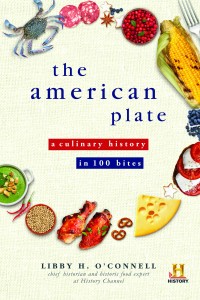
By Terri Schlichenmeyer
Everything looks so delicious.
It all smells great, too, and you can’t decide what you like best. The meat is done just right, potatoes are mashed to perfection, biscuits are to die for. And then there’s dessert! But – wait, leftovers. That’s your favorite…
You’ve got a lot on your plate this month, in more ways than one. And in “The American Plate” by Libby H. O’Connell, PhD, you’ll learn the stories our food can tell.
Imagine inviting a long-ago ancestor to dinner this week.
What he’d find at the table might astound him; surely, there’d be some dishes he wouldn’t even recognize. That’s because “remarkable changes in ingredients, recipes, and menus over the centuries” have changed how – and what – we eat.
That ancestor, for instance, might’ve enjoyed dining on grilled beavertail. Yum.
Then again, he’d know maize (corn, to us) very well. Native Americans grew it more than 9,000 years ago, and your ancestor might have had it in his garden, along with beans and squash, a farming method called the Three Sisters.
If he lived near the East Coast, he might’ve relished cod, though your Friday Night Fish Fry would seem pathetic to him. The cod he ate came in six foot long slabs, dried, salted, and kept stacked in his pantry. He might’ve added cow’s butter, dyed with gold flower petals, maybe some eel on the side, and bon appetit.
Of course, our ancestors had turkey, but they also ate offal (which sounds really awful). Those from the Netherlands brought doughnuts to the table. The British gave us syllabub. The Chinese gave us a dish, the words of which mean “odds and ends,” or chop suey. Pie was a group effort, originating from several different cultures.
Food played a role in who won The War Between the States, when Rebel forces nearly starved while Union soldiers enjoyed a bounty. At the turn of the last century, food created the first celebrity chefs. It became politicized some eighty-five years ago, then was frozen, served in front of the TV, and made fast.
And what does the future hold? Well, pull up a chair. That entrée isn’t done yet.
Ask five of your friends about their favorite comfort foods, and you’ll get five different stories that start out, “My mom made the best….”
Chances are that those dishes are found somewhere in “The American Plate.”
So many things that you’ll eat in the next few weeks are in this book, in fact, and there’s a story behind every one of them. Author and historian Libby H. O’Connell fills our minds with the things with which we fill our bellies, letting us literarily play with our food. We get plenty of aside-dishes, and – surprise! – recipes, so you, too, can try roast beavertail, syllabub, Hangtown Fry, scrapple, or Red Cross War Cake.
Historians and cooks will obviously love this book, but I think it’s also very appropriate for anyone who likes to eat. If that’s you, then dig in. You’ll devour “The American Plate” until there’s nothing left over.








